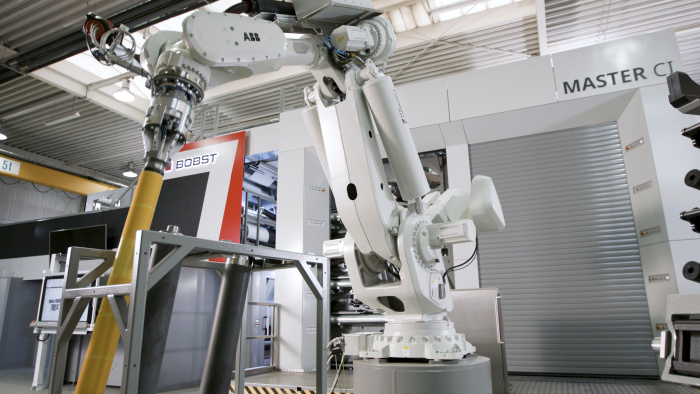The flexible packaging landscape is evolving fast, powered by an increase in demand for shorter runs, just-in-time delivery, greater agility, high quality, lower costs and more sustainable manufacturing processes and materials.
In order to respond to these challenges, BOBST has positioned itself as a global solutions provider with a presence along the entire value chain. By moving away from the role as traditional machinery manufacturer, BOBST is leading through innovation to shape the future of packaging production. Its vision of this future is based on four pillars – Digitalization, Automation, Sustainability, and Connectivity – which are incorporated into every new development and every new solution.
Increasing flexo efficiency with digitalization and automation
Digitalization is key to the transformation of packaging production. By driving flexo printing and its associated converting processes with digital data and removing manual input, BOBST is pushing the boundaries of traditional flexible packaging manufacturing for maximum efficiency and even faster time to market.
As an example, BOBST has introduced in the new smartGPS II plate mounter a digital quality control process for printing plates, which offers high resolution and fast quality checks, as well as automatic detection of printing parameters. The data from the mounter is digitally communicated to the printing press to support the automation features in set up and guarantee best quality print.
Digitalization goes hand in hand with automation. The new BOBST MASTER CI flexo press has been designed to optimize efficiencies by combining the most advanced automation technologies on the market today. It features a robotic system, which prepares the press by changing the printing and anilox cylinders without any operator intervention – the smartDROID can even change the doctor blades and the CI nip. Once the cylinders are in place, smartTHREAD performs fully automatic web threading, from unwind to rewind, in under three minutes. Color matching and ink consumption are optimized by smartCLEAN II and smartCOL. For maintenance purposes, SmartCAL is an automation calibration process that enables efficient and operator-independent calibration of the printing units, winders and nip section.
The entire printing process is monitored by the Job Recipe Management (JRM) system, which digitalizes the workflow and create a ‘digital twin’ of each roll of printed substrate by collecting all the production data in a digital file for verification, quality control and easy recall of jobs.
“BOBST has evolved the CI flexo printing so that it is today a fully digitalized and automated process, where waste and any variables that can adversely affect productivity have been eliminated,” said Marco Carrara, Technology Sales Director, CI-FLEXO.
Streamlining CI flexo printing with connectivity
The third pillar of the vision is connectivity. Full connectivity requires complete integration, with every process and every action optimized to transform the whole workflow into one digitally connected entity.
As a one-stop online platform, BOBST Connect is the digital link between production equipment, tooling, services and third-party software. From initial design file to final product, all steps of production are connected. This one-stop online platform of solutions works across pre-press, production and maintenance to support converters to meet demands for shorter lead times, smaller runs, enhanced color consistency, higher efficiencies and improved sustainability.
“BOBST Connect is a complete infrastructure that moves the focus from individual machine productivity to end-to-end solutions and workflows that will have a profound impact on the bottom line,” said Marco Carrara.

Making flexo printing sustainable
Last but not least, sustainability is top of the agenda for brand owners. Printers and converters need to respond to these demands by implementing systems that minimize waste and use materials that lessen the environmental impact of packaging.
BOBST is working with key industry partners to develop new solutions in all areas of CI flexo to reduce waste and increase efficiencies. Along with the waste reduction that can be demonstrated by the increase in digitalization and automation, new developments in inks and materials are also contributing to making CI flexo a more sustainable method.
As the industry begins to move away from non-recyclable, complex packaging structures to mono-material laminates and new metallizing technologies, BOBST has introduced the new oneBARRIER family of alternative and sustainable substrates. This includes a polypropylene (PP) duplex structure with transparent AIOx barrier and a polyethylene (PE) triplex structure with opaque metallized barrier for producing durable, high-quality graphics pouches and bags for food packaging applications.
On press, the BOBST oneECG printing technology is another great example of how to increase sustainability in CI flexo. By standardizing the printing process, this Extended Color Gamut (ECG) solution can bring significant savings due to faster job changeovers and color matching, along with 100% repeatability of job quality and color consistency. By digitizing color matching with oneECG, converters will be able to address much shorter runs effectively and reduce costs.
“The BOBST vision for the future of packaging production is present across all technologies in flexible packaging, be it printing, die-cutting, laminating, metallizing, or coating. Our strong know-how and experience are built into every solution,” concludes Marco Carrara. “This benefits our customers because we can guide them through every stage from end to end, as we embark on a new era in flexible packaging production.”
Biography
Marco Carrara
Technology Sales Director CI-FLEXO
Business Unit Printing and Converting
Marco Carrara joined BOBST in 2005 after Bobst’s acquisition of Valmet Converting. He occupied various roles in Marketing and Sales in the Business Unit Printing and Converting and is today the Technology Sales Director for the CI-Flexo Machines for the Americas and South Europe regions. Marco started in the industry 34 years ago, directly after school, in a full-time job as a Service Manager.
After finishing his mechanical engineering degree in Bergamo Italy, Marco spent 13 years at Valmet Converting. Marco is a recognized CI-Flexo industry specialist with a tremendous level of knowledge. In his current role, Marco drives innovations to answer the challenges of the Flexographic Industry.
